Investigation on Civil Engineering Application of Tyre Encased Soil Element: Laboratory Direct Shear Test and Supply Chain Analysis
Abstract
1. Introduction
2. Materials and Methods
2.1. Materials
2.2. Preparation of TESEs
2.3. Direct Shear Test Setup and Instrumentation
3. Laboratory Direct Shear Test Results and Discussions
3.1. Failure Mode
3.2. Normal Force-Shear Displacement Relationship
3.3. Shear Force-Shear Displacement Relationship
3.4. Shear Stress-Normal Stress Relationship and Interfacial Properties
4. EOL Tyre Re-Used Supply Chain Environment and Economic Analysis
5. Conclusions
- The shear failure was governed by an intercourse shear sliding and a small tilting of the top course TESE. No soil leakage was observed on the tested TESEs. The types of soils that can form good particle-particle interlocking after compaction (e.g., coarse aggregates) are recommended for constructing leak-proof TESEs.
- Using well-compacted coarse aggregates with a large particle size as the encased material may result in obvious dilation, which is not the case when using loose small-grain soils as the encased material. Due to the dilation effect, the lateral shear pressure may induce a vertically uplifting force to the above-supported structures.
- Using stiff coarse aggregates as encased materials would induce the TESE with a high frictional coefficient at the course-course interface. The same effect (high frictional coefficient) could be achieved by reducing the amount of the encased soil to form a higher portion of rubber-to-rubber contact at the interface at the expense of a lower compressive load-bearing capacity.
- The supply chain environment and economic analysis revealed that using entire tyres to construct TESEs has lower carbon-dioxide emissions and more economic benefits than the traditional way of recycling waste tyres.
6. Limitations and Recommendations
Author Contributions
Funding
Institutional Review Board Statement
Informed Consent Statement
Data Availability Statement
Acknowledgments
Conflicts of Interest
References
- Gilson, Tyre Stewardship Australia Annual Report; Tyre Stewardship: Collingwood, Australia, 2017.
- Garga, V.K.; O’Shaughnessy, V. Tire-reinforced earthfill. Part 1: Construction of a test fill, performance, and retaining wall design. Can. Geotech. J. 2000, 37, 75–96. [Google Scholar] [CrossRef]
- Li, L.; Shi, A.; Zhang, L.; Xiao, H.; Jiang, M. Experimental investigations on the mechanically stabilised earth wall under static load conditions. Eur. J. Environ. Civ. Eng. 2018, 25, 575–598. [Google Scholar] [CrossRef]
- Ab-Malek, K.; Stevenson, A. The effect of 42 year immersion in sea-water on natural rubber. J. Mater. Sci. 1986, 21, 147–154. [Google Scholar] [CrossRef]
- Long, N.T.; Audeoud, B.; Bailly, J.C.; Jean, P.A.; Lareal, P.; Ursat, P.; Valeux, J.C. Etudes et Recherches des Laboratoires des Ponts et Chaussees-Serie Geotechnique; Laboratoire Central des Ponts et Chausees (LCPC): Paris, France, 1990. [Google Scholar]
- Huat, B.B.K.; Aziz, A.A.; Chuan, L.W. Application of scrap tires as earth reinforcement for repair of tropical residual soil slope. Electron. J. Geotech. Eng. 2009, 13, 1–9. [Google Scholar]
- Li, L.; Xiao, H.-l.; Zheng, J.-j.; Chen, L.; Sun, M.-j.; Sun, L.; Yang, C. The model test of waste tire reinforced slope. Gongcheng Lixue Eng. Mech. 2015, 32, 79–85. [Google Scholar] [CrossRef]
- Li, L.; Xiao, H.; Ferreira, P.; Cui, X. Study of a small scale tyre-reinforced embankment. Geotext. Geomembr. 2016, 44, 201–208. [Google Scholar] [CrossRef]
- O’Shaughnessy, V.; Garga, V.K. Tire-reinforced earthfill. Part 2: Pull-out behaviour and reinforced slope design. Can. Geotech. J. 2000, 37, 97–116. [Google Scholar] [CrossRef]
- Long, N.-T. Utilization of used tyres in civil engineering-The Pneusol’Tyresoil. In Environmental Geotechnics; Laboratoire Central des Ponts et Chausees (LCPC): Paris, France, 1996; pp. 809–814. [Google Scholar]
- Yoon, Y.W.; Heo, S.B.; Kim, K.S. Geotechnical performance of waste tires for soil reinforcement from chamber tests. Geotext. Geomembr. 2008, 26, 100–107. [Google Scholar] [CrossRef]
- Indraratna, B.; Sun, Q.D.; Grant, J. Behaviour of subballast reinforced with used tyre and potential application in rail tracks. Transp. Geotech. 2017, 12, 26–36. [Google Scholar] [CrossRef]
- Sun, Q.; Indraratna, B.; Heitor, A. Behaviour of a capping layer reinforced with recycled tyres. Proc. Inst. Civ. Eng. —Ground Improv. 2019, 172, 127–137. [Google Scholar] [CrossRef]
- Mistry, M.K.; Shukla, S.J.; Solanki, C.H. Reuse of waste tyre products as a soil reinforcing material: A critical review. Environ. Sci. Pollut. Res. 2021, 28, 24940–24971. [Google Scholar] [CrossRef] [PubMed]
- Xu, Y.; Freney, M.; Hassanli, R.; Zhuge, Y.; Rahman, M.; Karim, R. Experimental study on the structural performance of full-scale tyre wall for residential housing applications. Eng. Struct. 2022, 259, 114181. [Google Scholar] [CrossRef]
- Awan, A.; Shaikh, F. Experimental and numerical study on structural behaviour of tyre-bale sandwich wall under different loading conditions. Aust. J. Struct. Eng. 2021, 22, 299–316. [Google Scholar] [CrossRef]
- Esbelin, G.; Long, N.; Ursat, P. Pneusol at the Bussang pass. In Proceedings of the Third International Conference on Case Histories in Geotechnical Engineering, St. Louis, MO, USA, 1–4 June 1993. [Google Scholar]
- O’Shaughnessy, V. Reinforcement of Earth Structures Using Scrap Tires; University of Ottawa: Ottawa, ON, Canada, 1997. [Google Scholar]
- Indraratna, B.; Sun, Q.; Heitor, A.; Grant, J. Performance of rubber tire-confined capping layer under cyclic loading for railroad conditions. J. Mater. Civ. Eng. 2018, 30, 06017021. [Google Scholar] [CrossRef]
- Sun, Q.; Indraratna, B.; Grant, J. Numerical Simulation of the Dynamic Response of Ballasted Track Overlying a Tire-Reinforced Capping Layer. Front. Built Environ. 2020, 6, 115. [Google Scholar] [CrossRef]
- Anburuvel, A. Utilizing Scrap Tyre in Unbound Pavement Layers: A State-of-the-Art Review. Int. J. Pavement Res. Technol. 2022, 1–18. [Google Scholar] [CrossRef]
- Freney, M.; Soebarto, V.; Williamson, T. Thermal comfort of global model earthship in various European climates. In Proceedings of the Building Simulation 2013: 13th International Conference of the International Building Performance Simulation Association, Chambéry, France, 26–28 August 2013; pp. 1625–1632. [Google Scholar]
- Freney, M.; Soebarto, V.; Williamson, T. Earthship monitoring and thermal simulation. Archit. Sci. Rev. 2013, 56, 208–219. [Google Scholar] [CrossRef]
- Freney, M. Earthship architecture: Post occupancy evaluation, thermal performance & life cycle assessment. In School of Architecture and Built Environment; The University of Adelaide: Adelaide, Australia, 2014. [Google Scholar]
- Grindley, P.C.; Hutchinson, M. The thermal behaviours of an earthshi Renew. Energy 1996, 8, 154–159. [Google Scholar]
- Griepentrog, T.E. Engineering Evaluation of Earth-Filled Tire Construction, Dennis Weaver Residence, Ridgway, Colorado; Buckhorn Geotech: Montrose, CO, USA, 1990. [Google Scholar]
- Zimmerman, A.; Burger, E.; Nolan, J. Testing and analysis of modified rammed earth tyre walls. In E90 Project; Swarthmore College: Swarthmore, PA, USA, 2011. [Google Scholar]
- Fan, K.; Liu, S.H.; Cheng, Y.; Liao, J. Effect of infilled materials and arrangements on shear characteristics of stacked soilbags. Geosynth. Int. 2020, 27, 662–670. [Google Scholar] [CrossRef]
- Ahmed, G.H.; Aziz, O.Q. Shear behavior of dry and epoxied joints in precast concrete segmental box girder bridges under direct shear loading. Eng. Struct. 2019, 182, 89–100. [Google Scholar] [CrossRef]
- Casapulla, C.; Argiento, L.U. In-plane frictional resistances in dry block masonry walls and rocking-sliding failure modes revisited and experimentally validated. Compos. Part B: Eng. 2018, 132, 197–213. [Google Scholar] [CrossRef]
- Bu, Z.-Y.; Zhang, X.; Ye, H.-H.; Xi, K.; Wu, W.-Y. Interface shear transfer of precast concrete dry joints in segmental columns. Eng. Struct. 2018, 175, 257–272. [Google Scholar] [CrossRef]
- Beconcini, M.L.; Croce, P.; Formichi, P.; Landi, F.; Puccini, B. Experimental Evaluation of Shear Behavior of Stone Masonry Wall. Materials 2021, 14, 2313. [Google Scholar] [CrossRef] [PubMed]
- ASTM D2487-11; Standard Practice for Classification of Soils for Engineering Purposes (Unified Soil Classification System). ASTM International: West Conshohocken, PA, USA, 2011.
- Li, L.; Cui, F.; Xiao, H.; Ma, Q.; Qin, L. Shear Performance of Waste Tires, Geogrid and Geocell Reinforced Soils; Springer: Singapore, 2018; pp. 463–472. [Google Scholar]
- ASTM D638-14; Standard Test Method for Tensile Properties of Plastics. ASTM International: West Conshohocken, PA, USA, 2014.
- AS 1289.3.6.1-2009; Methods of Testing Soils for Engineering Purposes—Soil Classification Tests—Determination of the Particle Size Distribution of a Soil—Standard Method of Analysis by Sieving. Standards Australia Limited: Sydney, Australia, 2009.
- AS 1289.5.1.1; Methods of Testing Soils for Engineering Purposes—Soil Compaction and Density Tests—Determination of the Dry Density/Moisture Content Relation of a Soil using Standard Compactive Effort. Standards Australia Limited: Sydney, Australia, 2017.
- AS 1289.3.1.1-2009; Methods of Testing Soils for Engineering Purposes—Soil Classification Tests—Determination of the Liquid Limit of a Soil—Four Point Casagrande Method. Standards Australia Limited: Sydney, Australia, 2009.
- AS 1289.3.2.1-2009; Methods of Testing Soils for Engineering Purposes—Soil Classification Tests—Determination of the Plastic Limit of a Soil—Standard Method. Standards Australia Limited: Sydney, Australia, 2009.
- AS 1289.3.3.1-2009; Methods of Testing Soils for Engineering Purposes-Soil Classification Tests—Calculation of the Plasticity Index of a Soil. Standards Australia Limited: Sydney, Australia, 2009.
- Reynolds, M. Earthship Volume 1: How to Build Your Own; Solar Survival Pr.: Taos, NM, USA, 1990. [Google Scholar]
- Bowden, F.P.; Bowden, F.P.; Tabor, D. The Friction and Lubrication of Solids; Oxford University Press: Oxford, UK, 2001; Volume 1. [Google Scholar]
- AUSTROADS. ‘92 Austroads Bridge Design Code; Austroads: Sydney, Australia, 1992. [Google Scholar]
- SN 670 010b; Characteristic Coefficients of Soils, Association of Swiss Road and Traffic Engineers Swiss Standard, in Characteristic Coefficients of soils. Association of Swiss Road and Traffic Engineers: Zürich, Switzerland, 1997.
- Neal, M.S. Friction and adhesion between soil and rubber. J. Agric. Eng. Res. 1966, 11, 108–112. [Google Scholar] [CrossRef]
- Randell, P.; Baker, B.; O’Farrell, K. Used Tyres supply Chain and Fate Analysis; Randell Environmental Consulting: Castlemaine, VA, USA, 2020. [Google Scholar]
- Liu, Y.; Zhuge, Y.; Chow, C.W.; Keegan, A.; Li, D.; Pham, P.N.; Li, L. Compressive behaviour and environmental evaluation of sludge-derived masonry walls. Case Stud. Constr. Mater. 2021, 15, e00736. [Google Scholar] [CrossRef]
- Tyre Stewardship Australia. Used Tyres Supply Chain and Fate Analysis Report; Tyre Stewardship: Collingwood, Australia, 2020. [Google Scholar]
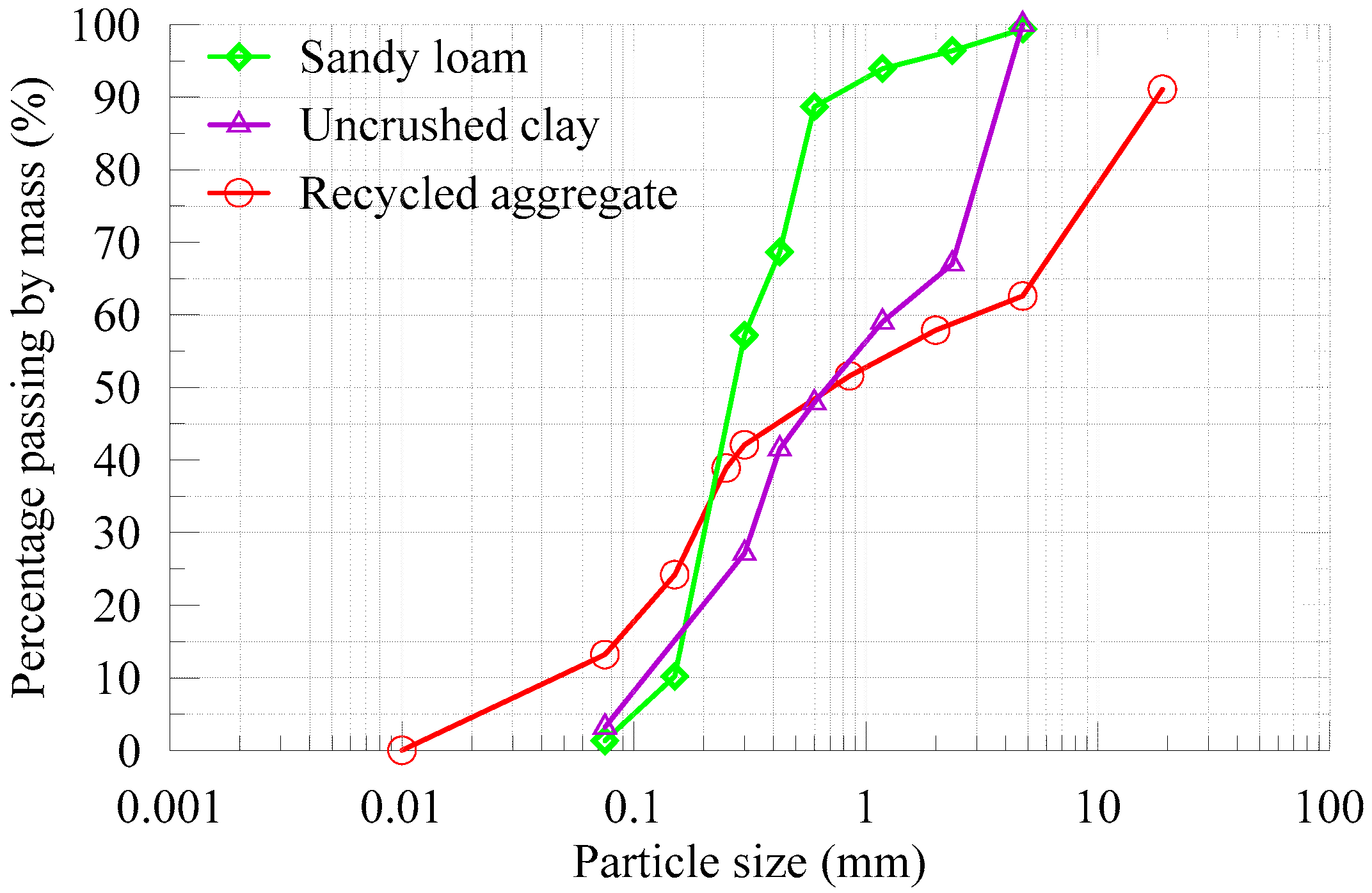
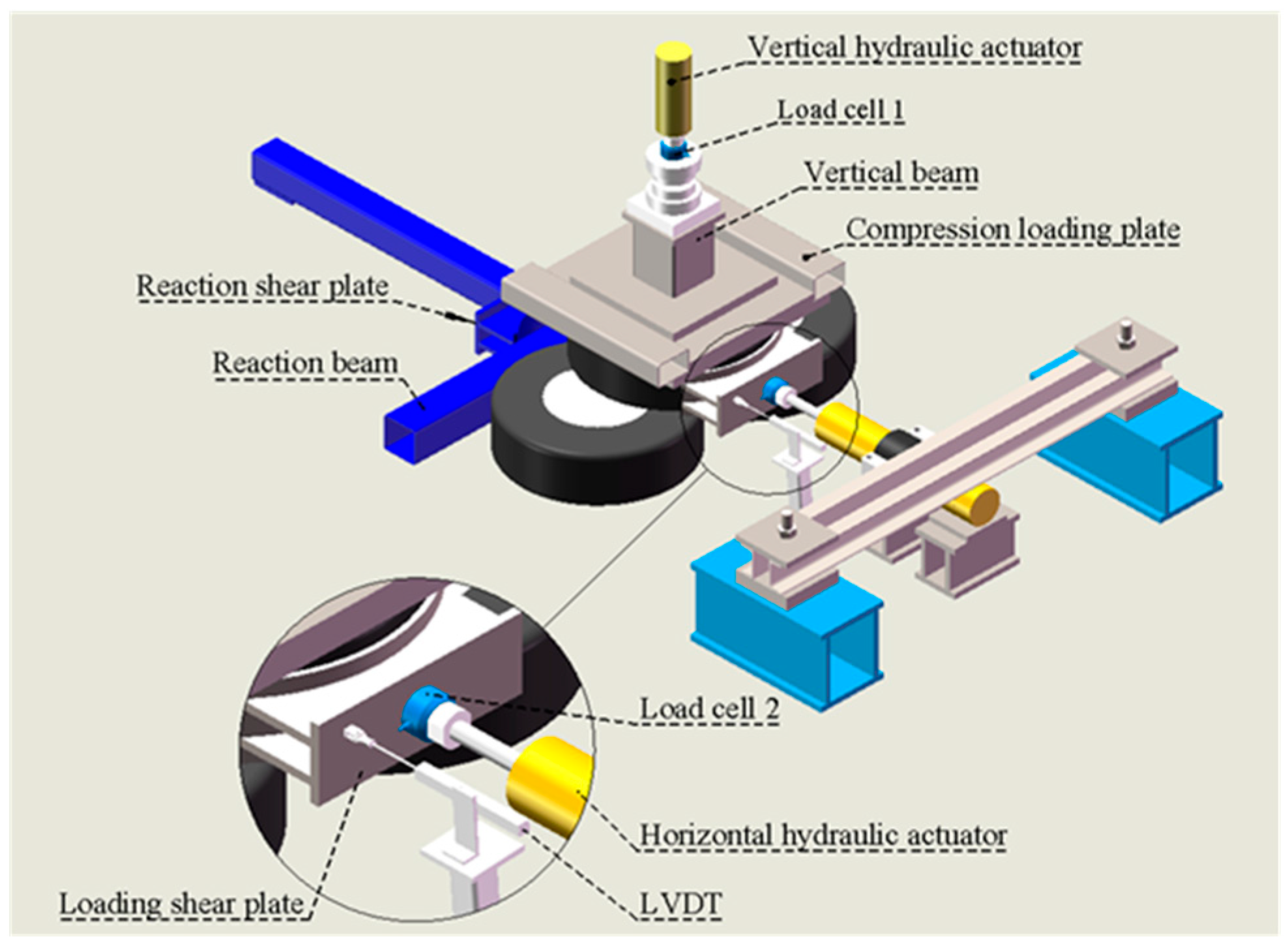

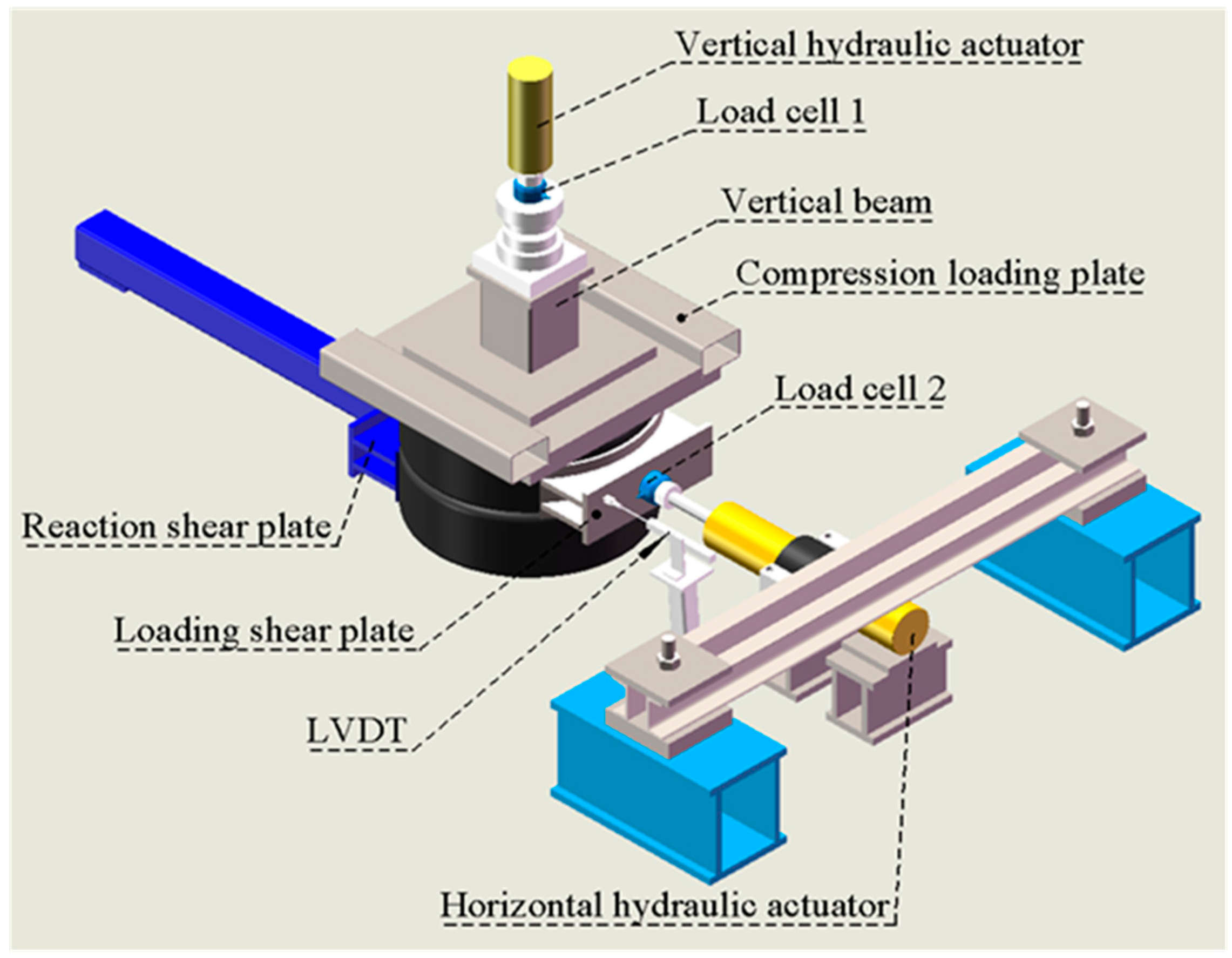
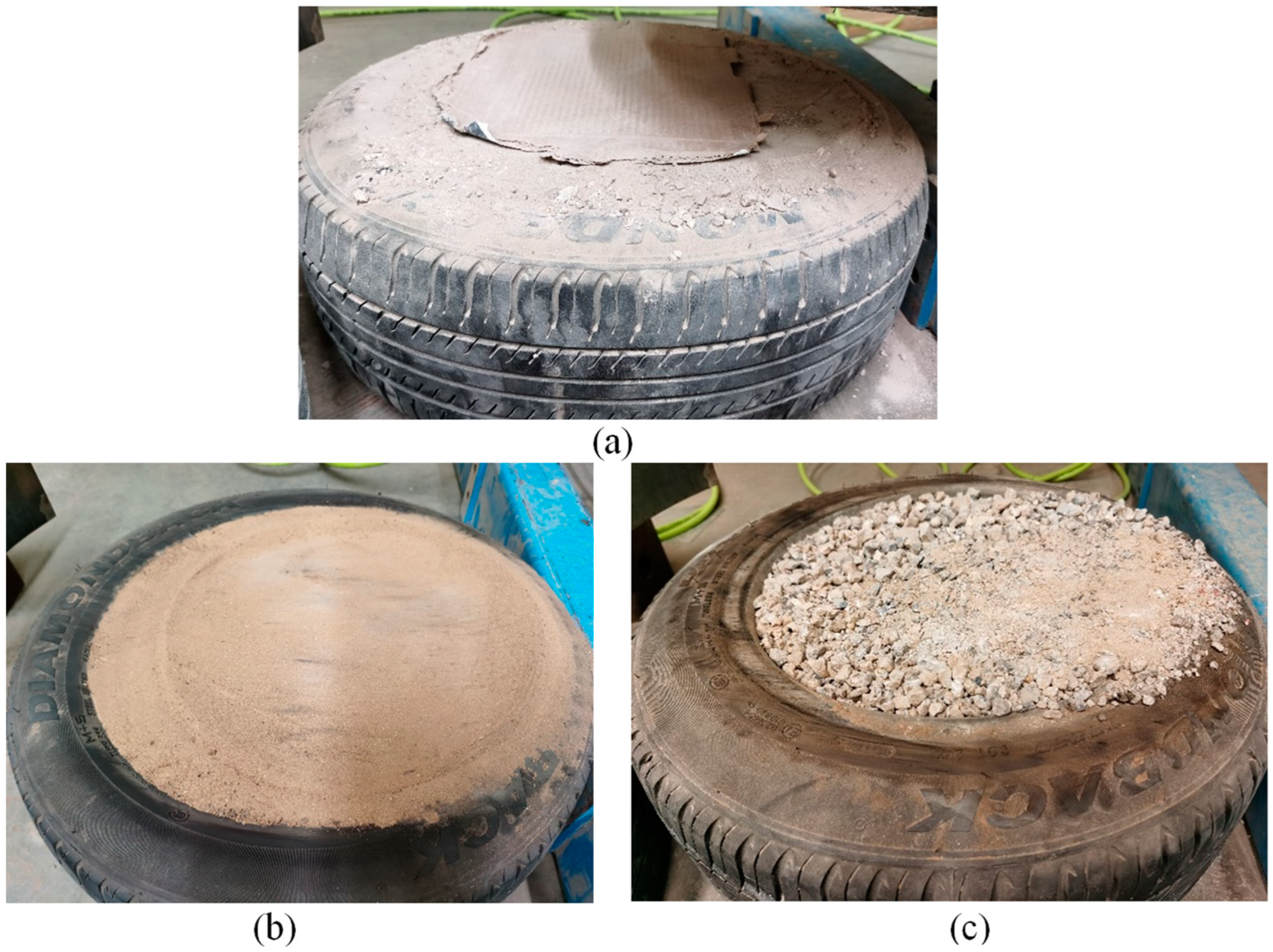
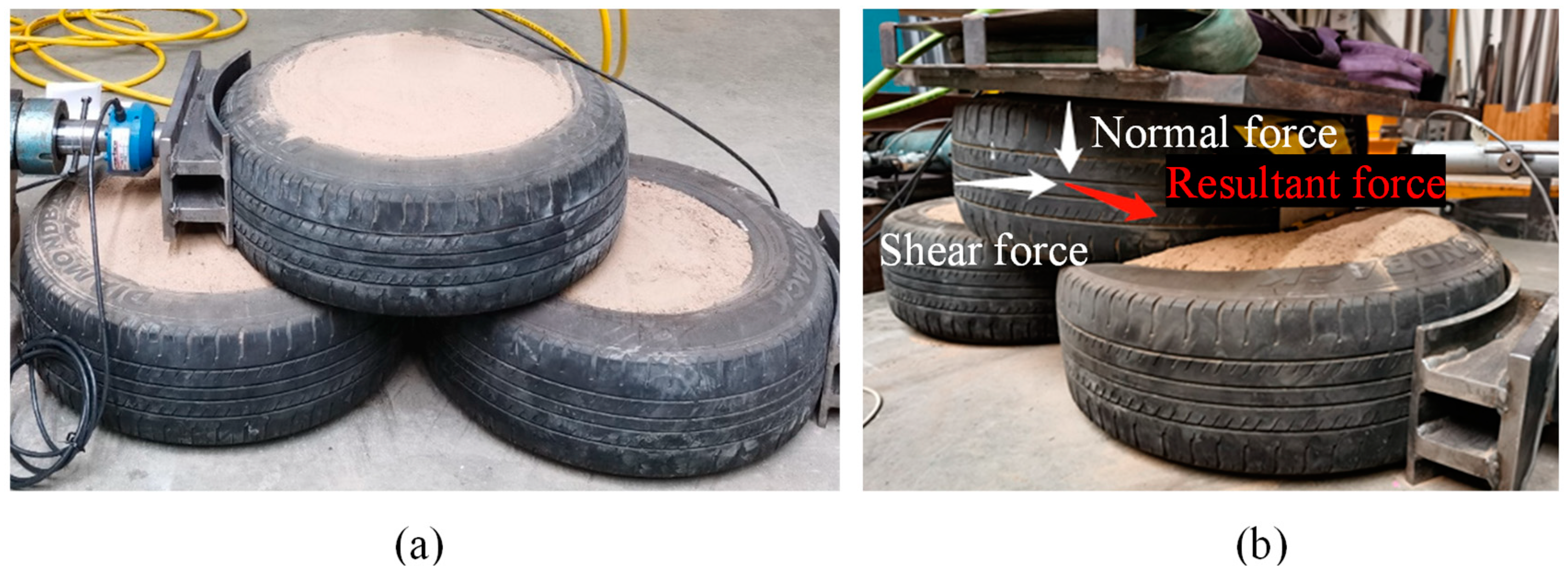
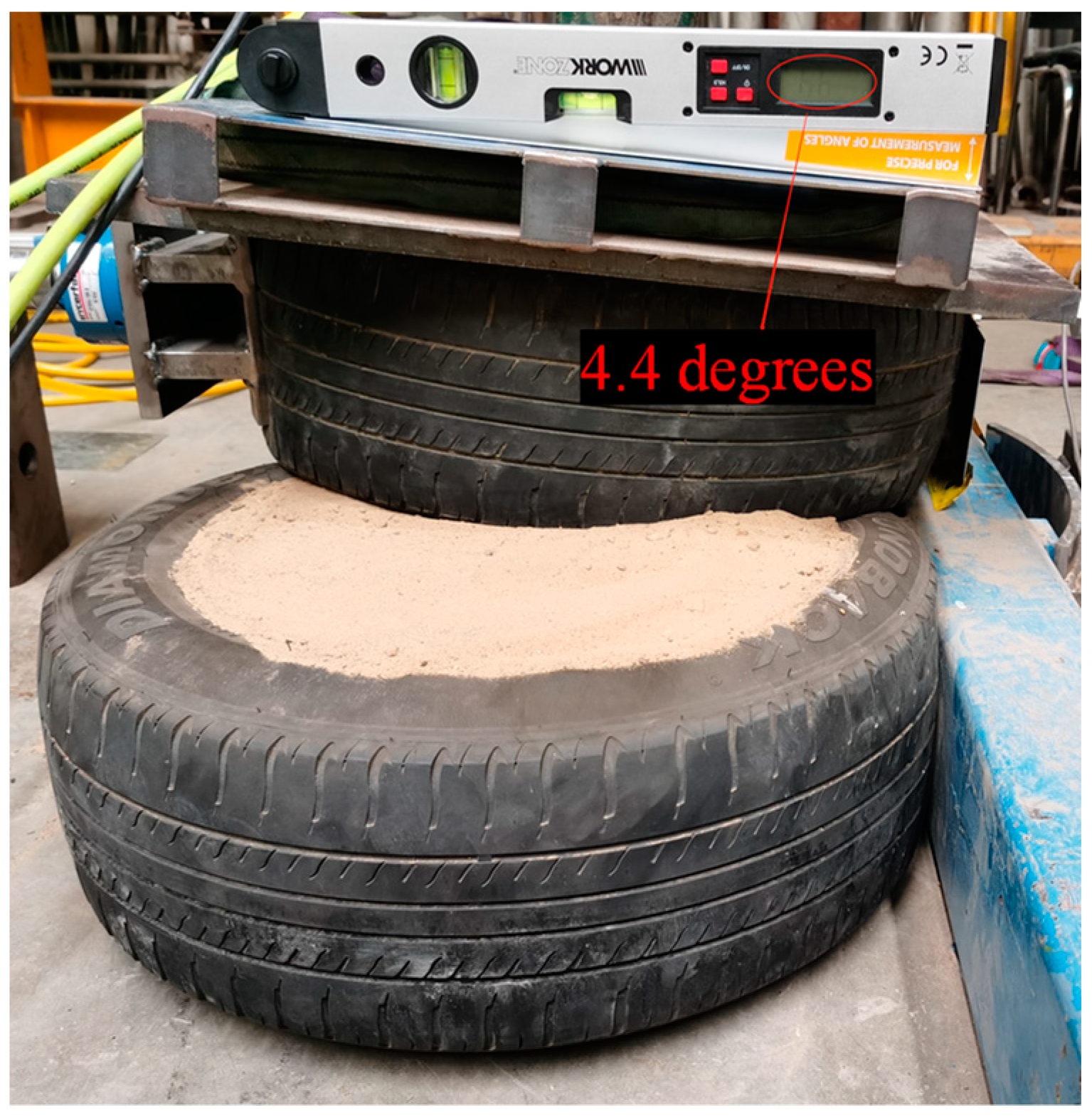


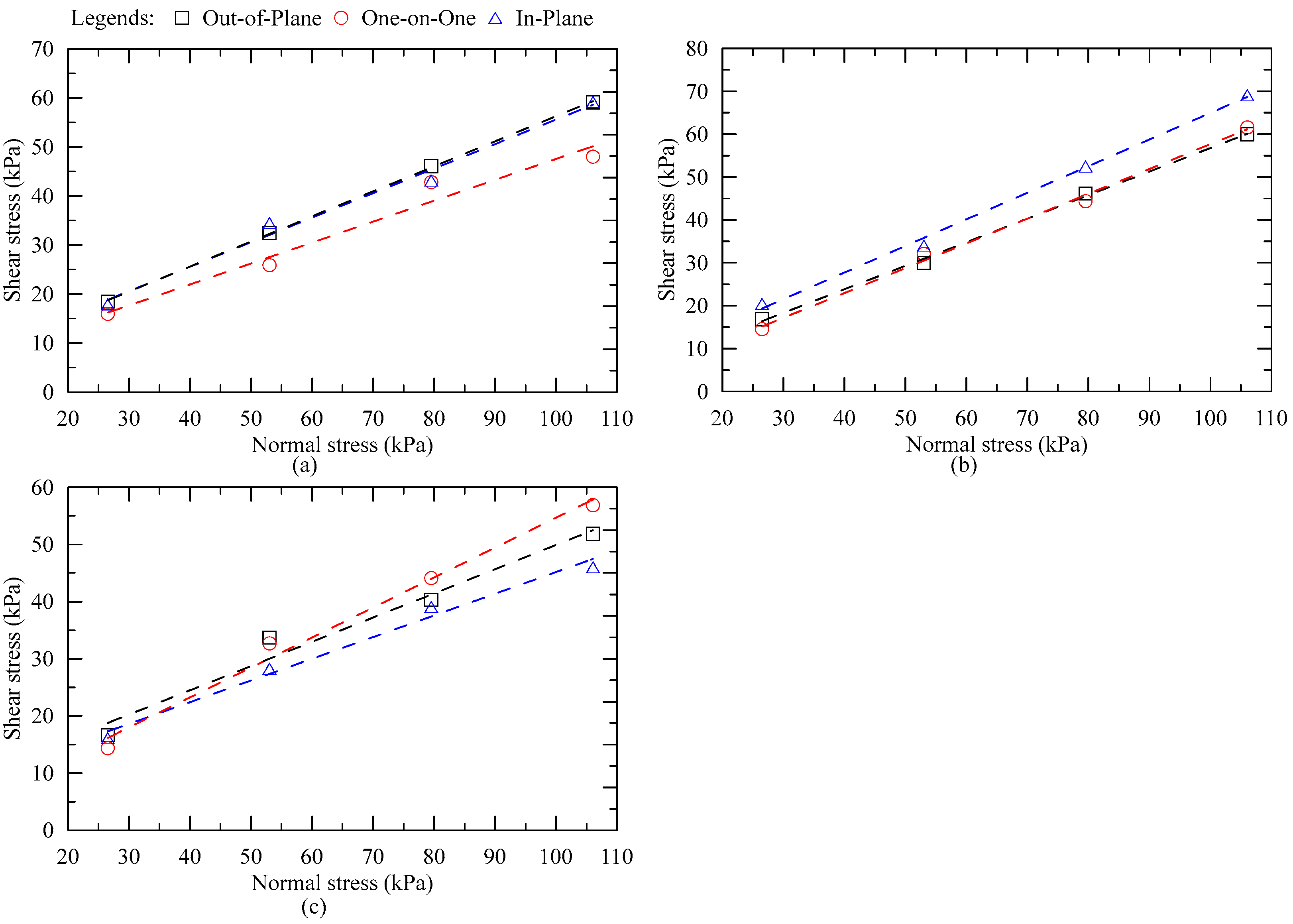
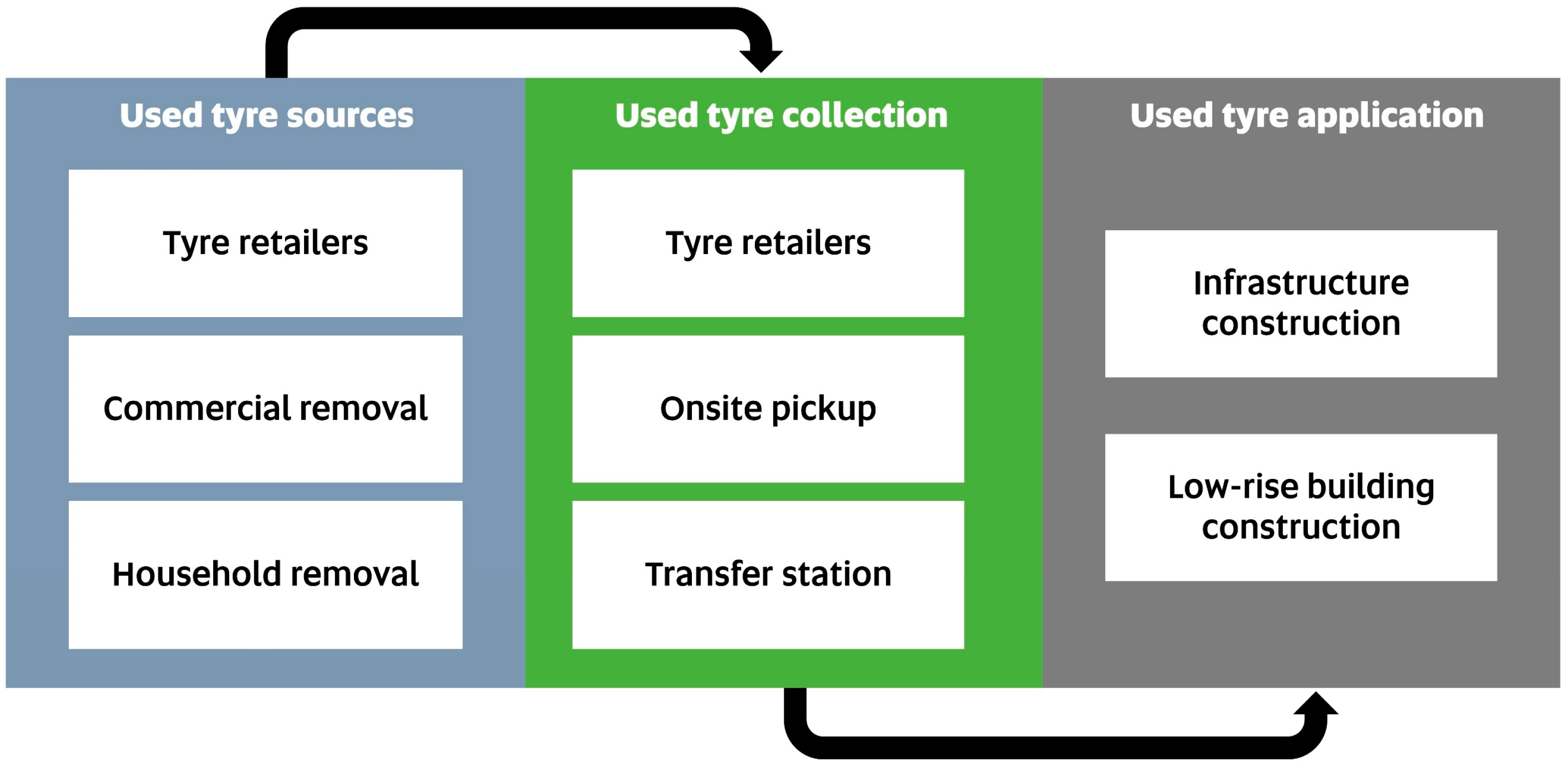
| Properties | Sandy Loam | Recycled Aggregate | Uncrushed Clay | Standards |
|---|---|---|---|---|
| Maximum grain size, (mm) | 4.75 | 32 | 55 * | AS 1289.3.6.1 [36] |
| Minimum grain size, (μm) | 0.5 | 0.4 | 0.3 * | AS 1289.3.6.1 [36] |
| Coefficient of uniformity, | 2.2 | 57.0 | 19.7 * | ASTM D2487 [33] |
| Coefficient of curvature, | 1.0 | 0.3 | 0.3 * | ASTM D2487 [33] |
| Maximum dry density, (t/m3) | 1.69 | 1.81 | 1.79 | AS 1218.5.1.1 [37] |
| Optimum moisture content, (%) | 12.3 | 15.0 | 8.6 | AS 1218.5.1.1 [37] |
| Liquid limit, (%) | 25 | 26 | 33.6 | AS 1289.3.1.1 [38] |
| Plastic limit, (%) | 20 | 24 | 23.5 | AS 1289.3.2.1 [39] |
| Plastic index, (%) | 5 | 2 | 10.1 | AS 1289.3.3.1 [40] |
| USCS classification | SP | SM | CL | ASTM D2487 [33] |
| Properties | Values | Standards |
|---|---|---|
| Standard size | 175/65R14 | - |
| Outside diameter (mm) | 584 | - |
| Rim diameter (mm) | 355.6 | - |
| Tread height (mm) | 175 | - |
| Average thickness (mm) | 12 | - |
| Average tensile stress at 2% strain (MPa) | 2.1 | ASTM D638-14 [35] |
| Average tensile stress at 5% strain (MPa) | 5.2 | ASTM D638-14 [35] |
| Average ultimate strain (%) | 13.1 | ASTM D638-14 [35] |
| Average ultimate tensile strength (MPa) | 14.1 | ASTM D638-14 [35] |
| Out-of-Plane Figure 2 | In-Plane Figure 3 | One-on-One Figure 4 | |
|---|---|---|---|
| Sandy loam | √ | √ | √ |
| Recycled aggregate | √ | √ | √ |
| Uncrushed clay | √ | √ | √ |
| Encased Material | Test Setup | Interlocking Stress (kPa) | Frictional Coefficient |
|---|---|---|---|
| Clay | In-plane | 5.57 | 0.50 |
| One-on-one | 4.89 | 0.43 | |
| Out-of-plane | 5.17 | 0.51 | |
| Recycled aggregate | In-plane | 2.92 | 0.62 |
| One-on-one | 0.19 | 0.58 | |
| Out-of-plane | 1.86 | 0.55 | |
| Sand | In-plane | 7.24 | 0.38 |
| One-on-one | 2.27 | 0.52 | |
| Out-of-plane | 7.55 | 0.42 |
| Fate | Total Cost (Million AU$) | References | |
|---|---|---|---|
| Re-use | Low-rise residential construction | 3.9 | |
| Recycling | Shredded tyre | 4.6 | Tyre Stewardship Australia [48] |
| Granule (2–15 mm) | 15.6 | Tyre Stewardship Australia [48] | |
| Buffings (<2 mm) | 15.6 | Tyre Stewardship Australia [48] | |
| Crumb rubber (power) | 18.7 | Tyre Stewardship Australia [48] | |
Publisher’s Note: MDPI stays neutral with regard to jurisdictional claims in published maps and institutional affiliations. |
© 2022 by the authors. Licensee MDPI, Basel, Switzerland. This article is an open access article distributed under the terms and conditions of the Creative Commons Attribution (CC BY) license (https://creativecommons.org/licenses/by/4.0/).
Share and Cite
Xu, Y.; Zhuge, Y.; Rahman, M.M.; Karim, M.R.; Hassanli, R.; Luo, L.; Freney, M. Investigation on Civil Engineering Application of Tyre Encased Soil Element: Laboratory Direct Shear Test and Supply Chain Analysis. Sustainability 2022, 14, 14852. https://doi.org/10.3390/su142214852
Xu Y, Zhuge Y, Rahman MM, Karim MR, Hassanli R, Luo L, Freney M. Investigation on Civil Engineering Application of Tyre Encased Soil Element: Laboratory Direct Shear Test and Supply Chain Analysis. Sustainability. 2022; 14(22):14852. https://doi.org/10.3390/su142214852
Chicago/Turabian StyleXu, Yachong, Yan Zhuge, Md. Mizanur Rahman, Md. Rajibul Karim, Reza Hassanli, Li Luo, and Martin Freney. 2022. "Investigation on Civil Engineering Application of Tyre Encased Soil Element: Laboratory Direct Shear Test and Supply Chain Analysis" Sustainability 14, no. 22: 14852. https://doi.org/10.3390/su142214852
APA StyleXu, Y., Zhuge, Y., Rahman, M. M., Karim, M. R., Hassanli, R., Luo, L., & Freney, M. (2022). Investigation on Civil Engineering Application of Tyre Encased Soil Element: Laboratory Direct Shear Test and Supply Chain Analysis. Sustainability, 14(22), 14852. https://doi.org/10.3390/su142214852









